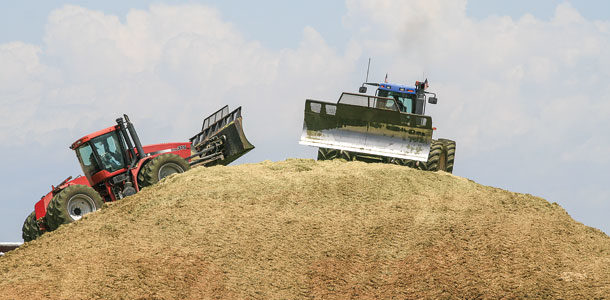Across the U.S. dairy industry and around the world, fermented and ensiled forages and grains have become popular feedstuffs in dairy herd diets. Fermentation and ensiling allows dairy farms to preserve forages that cannot be dried properly for baling and would otherwise decay before they could be fed out.
Fermented and ensiled feedstuffs make possible a constant and consistent supply of fiber, protein and energy for dairy herds throughout the year. The primary goal of fermentation is to preserve as much organic matter as possible to be stored and used as future feed for the dairy herd.
Many factors affect the fermentation and ensiling process and the quality and stability of a pile or silo of silage. Moisture at the time of harvesting, chop length, silo packing speed and silage pack density will all influence the quality of silages.
Just as importantly, how well the bunk is covered for storage, keeping air and moisture out and how well the face of a pile of silage is managed will also influence the quality of the silage after it has been ensiled. Poor fermentations can lead to excessive effluent runoff (a potential environmental hazard), loss of nutrients and the production of spoiled silage not fit for feeding.
Along with grasses and legumes, small-grain forages such as barley, oats and hybrids such as triticale are regularly harvested and stored as ensiled feeds. However, corn (maize) is far and away the most popular ensiled feedstuff due to its superior harvested tonnage and calories to the acre.
Also a member of the grass family, corn provides significant levels of nutrition from both starch and cellulose – a combination unique among forages.
Due to its size and structure, the corn plant cannot be mowed, dried, cured and baled like alfalfa or pasture grasses. It must be chopped into smaller pieces, packed and stored in airtight silos or bunkers.
Grasses and legumes, with their smaller stem sizes, can be wilted, crushed and packed, and made into high-quality silage as well. The fermentation process that takes place immediately after harvesting is what turns forages into “silage.”
Fermentation and ensiling of forages is essentially a two-step process: the removal of air while the forage is being packed and the final production of lactic acid which lowers the pH and stabilizes the organic matter. The key to maintaining a pile of silage in good condition is keeping the exposure to air to a minimum during feedout.
Air is the enemy of the fermentation process and stability of silage. The decomposition of forage organic matter begins immediately once the forage is harvested and chopped due to the exposure to air.
Unwanted aerobic bacteria, yeasts and molds are present in the soil and begin competing for the carbohydrates in the plant material. This phase is undesirable since the aerobic bacteria consume soluble carbohydrates that might otherwise be available for the beneficial lactic acid bacteria.
During this oxidative process, there will be considerable heat produced which will, when hot enough, damage proteins in the forage resulting in loss of nutrients and organic matter. Rapidly squeezing the air out during the packing process is critical in keeping aerobic microbial activity to a minimum. The sooner the air is used up in the pile, the sooner the anaerobic process of fermentation can begin.
The formation of lactic acid is the intended end product of fermentation in a pile of silage. However, as the process begins initially, acetic acid is the first fermentation acid produced while the pH is in the range of 5.0. The pH measurement is on a scale from 1 to 14 with 7 indicating a level of neutrality – neither acidic nor alkaline.
Below 7 indicates increasing acidity. Above 7 indicates increasing alkalinity. Acids must be present in order for forages to ferment. As the pH drops, acetic acid production ends and the lactic acid bacteria take over and drop the pH even lower. Ideally, a well-fermented and stabilized pile of silage will have about three times the lactic acid levels relative to acetic acid.
The pH level of silages is extremely important, and the more rapidly the lactic acid stage can begin, the more quickly the silage will completely ferment and stabilize. The final pH of the ensiled forage depends largely on the type of forage being ensiled and the condition at the time of ensiling. Hay crops being made into haylage should reach a final pH of around 4.5 and corn silage near 4.0 – both indicating lactic acid production.
Fermentation profiles with inverted lactic and acetic acid levels usually indicate that the pile was slow to become anaerobic – meaning packing and removal of air was inadequate or slow. An elevated level of acetic acid does not mean the silage is bad. However, because acetic acid is less stable, organic matter can more quickly decompose when exposed to air during feedout.
Proper fermentation is also dependent upon the moisture levels of the forages at the time of packing. Moisture levels must be kept in a fairly narrow range; otherwise, other types of undesirable fermentation acids will be produced in the silage.
Regardless of the type of forage – corn or hay crop – harvesting or chopping at moisture levels above 75 percent usually result in undesirable fermentation.Excessively wet silage, especially hay crops, result in a clostridial fermentation (from clostridium bacteria), resulting in the formation of butyric acid. The presence of high levels of butyric acid in a pile of silage indicates poorly planned or managed harvesting.
Any silage with a high level of butyric acid should be managed and fed out cautiously. High concentrations of butyric acid have been found to cause ketosis in lactating cows because the liver thinks the butyric acid is an energy source. It is not. One study suggests butyric acid levels in a diet should remain below 50 grams per day.
This would suggest that feeding more than 10 pounds of hay crop silage (dry matter basis) that tests higher than 1 percent for butyric acid would be problematic and would be a cause for health concerns in dairy cows. Feeding silages with high butyric acid to calves and heifers should be avoided completely. Butyric acid can also alter proteins that can adversely affect animal health as well.
Low levels of fermentation acids indicate there was not adequate moisture in the crop – it was harvested too dry. Fermentation acids form in the presence of water, and a high pH (indicating alkalinity) indicates a restricted or reduced fermentation.
Dry silages are usually unstable when exposed to air and quickly begin to heat up and develop a secondary fermentation, quickly creating molds and making the crop unpalatable. Removing silage from a pile and storing it temporarily at another location is highly discouraged, once again due to secondary fermentation and oxidation due to exposure to air.
Corn silage has become the king of silages in dairy cow diets due to its uniformity and predictability in growing and harvesting and the presence of high levels of carbohydrates that stimulate the fermentation process and provide metabolizable energy to the cow.
The recommended moisture level of a corn crop at harvesting is between 30 and 35 percent. Wetter than that can cause problems. Drier than that can cause problems. Kernel processing has become popular when corn is on the dry side, aiding with the rapid fermentation and availability of starch both for fermentation and rumen digestibility.
High-quality grass and legume forages will supply significant levels of energy and protein to dairy cow diets. However, hay crop silages are much more susceptible to adverse fermentation situations, either being harvested too wet or too dry. Dry matter for a well-fermented haylage should be 40 to 45 percent.
Due to their chemical makeup and lower levels of carbohydrates, the pH level in grasses and legumes is more difficult to lower. It’s also more difficult to pack a pile of hay crop and squeeze out air due to the physical structure of the plants. The combination of high or low moisture, along with difficulty of removing air, can inhibit making good silage out of hay crops.
In well-fermented silages, lactic acid should be at least 65 to 75 percent of total fermentation acids with lower levels of acetic and no butyric or propionic acid. Even though propionic acid is desirable in the rumen as an energy precursor, it is not desirable in a pile of silage – again, its presence indicates a suboptimal fermentation.
In the rumen, lactic acid from silage is rapidly converted to propionic acid. However, lactic acid is a potent acid and can contribute to rumen acidosis if the rumen microbes are not adapted to its presence. As with all diets for milk cows, changes in silages with different fermentation profiles, or silages with undesirable profiles, should be made slowly.
Ensiled forages represent a sizable investment for dairy farmers, and poorly fermented silages can be a real train wreck for a dairy. With the cost of feeding cows amounting to half or more of total operating expenses, growing, harvesting, storing and managing ensiled feeds improperly can cost a dairy operation dearly.
While this article does not promote any specific brand of silage inoculant, it is highly recommended that bacterial inoculants be used on all forages intended for ensiling. The primary purpose for adding bacterial inoculants is to increase the lactic acid production in a pile of forage and ultimately preserving and recovering more organic matter which, in the end, is money in the dairy farmer’s pocket. PD
PHOTO: Staff photo.

-
John Hibma
- Nutritionist
- Central Connecticut Co-operative Farms Association
- Email John Hibma






